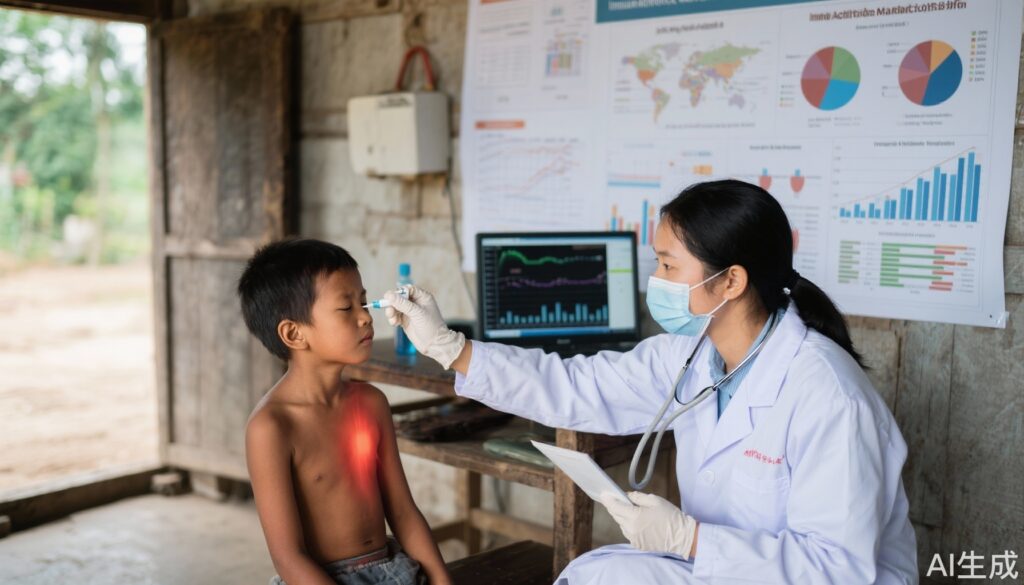Highlight
– Soluble TREM1 (sTREM1) outperforms WHO danger signs and other scoring systems in prognosticating severe febrile illness in children aged 1-59 months across rural Asian settings.
– Incorporating sTREM1 measurement into community-based triage could enable earlier, more accurate identification of children at risk of poor outcomes from febrile illnesses.
– The prospective multi-country cohort study affirms sTREM1’s superior predictive performance (AUC 0.86) compared to established clinical scores and biomarkers.
– Immune and endothelial activation markers provide differential prognostic value, particularly in children who develop severe illness beyond 48 hours after presentation.
Study Background and Disease Burden
Febrile illnesses represent a leading cause of childhood morbidity and mortality globally, especially in resource-constrained rural areas of Asia. Detecting which children with common infections will progress to severe disease requiring advanced care remains a critical unmet medical need. Existing clinical criteria such as WHO danger signs and systemic inflammatory response syndrome (SIRS) scores have variable accuracy and may lack sensitivity or specificity. Biomarkers reflecting host immune and endothelial activation have emerged as promising prognostic tools that could help optimize triage and resource allocation by more accurately identifying children at risk of deterioration early in their illness course. This is particularly urgent in settings where health care access is limited and delays in escalation of care contribute to high mortality.
Study Design
The Spot Sepsis study was a prospective cohort investigation conducted at seven hospitals serving rural populations in Bangladesh, Cambodia, Indonesia, Laos, and Viet Nam, positioned as the first points of formal healthcare contact. The study enrolled 3,423 children aged 1 to 59 months presenting with acute community-acquired febrile illness lasting no more than 14 days. Baseline demographic and clinical parameters, including WHO danger signs, Liverpool quick Sequential Organ Failure Assessment (LqSOFA), and SIRS scores, were recorded at presentation. Simultaneously, plasma concentrations of multiple immune activation markers (including CHI3L1, CRP, IP-10, IL-1ra, IL-6, IL-8, IL-10, PCT, soluble TNF-R1, soluble TREM1 [sTREM1], soluble uPAR) and endothelial activation markers (ANG-1, ANG-2, soluble FLT-1) were measured. The primary endpoint was progression to severe febrile illness, defined as death or receipt of organ support, occurring within 2 days after enrolment. The study uniquely applied weighted area under the receiver operating characteristic curves (AUC) for comparison of biomarker and clinical assessment prognostic accuracies and assessed combined models incorporating best performing biomarkers with clinical signs. The study is registered under ClinicalTrials.gov (NCT04285021).
Key Findings
Of 3,405 evaluable participants, 133 (3.9%) developed severe febrile illness, with 22 deaths and 111 requiring organ support, producing a weighted prevalence of 0.34%. Overall, sTREM1 displayed the highest prognostic accuracy with an AUC of 0.86 (95% CI 0.82-0.90), significantly outperforming WHO danger signs (AUC 0.75), LqSOFA score (AUC 0.74), and SIRS score (AUC 0.63) (all p < 0.0001). Notably, combining sTREM1 measurement with WHO danger signs did not substantially improve predictive accuracy beyond sTREM1 alone (AUC 0.88 vs. 0.86; p=0.24).
Sensitivity analysis revealed that sTREM1 had a higher sensitivity (80%) for detecting children who would progress to severe illness compared with WHO danger signs (72%), while their specificities were similar (81% vs. 79%). An important clinical metric, the number needed to test (NNT) to detect one additional child who progressed to severe disease, was markedly lower with sTREM1 compared to WHO danger signs (NNT=3000).
Further, discriminative power of immune and endothelial activation markers, including sTREM1, was superior among children who developed severe illness more than 48 hours after enrolment (AUC 0.94). This indicates the potential utility of these biomarkers for early recognition of children at risk despite initial clinical stability.
Expert Commentary
This landmark multi-country prospective cohort study robustly validates sTREM1 as a superior biomarker for early risk stratification in childhood febrile illnesses within rural Asian contexts. The robust sample size and geographic diversity enhance the generalizability and pragmatic value. Importantly, this study exemplifies the evolving paradigm shifting from symptom-based clinical assessment toward integration of molecular biomarkers in front-line clinical decision-making, particularly where resource constraints limit advanced diagnostics.
sTREM1, a soluble triggering receptor expressed on myeloid cells, reflects innate immune activation, a key pathophysiological process driving progression to severe infection and sepsis. Prior smaller studies implicated sTREM1 in sepsis diagnostics; the Spot Sepsis study advances this by direct comparison against standard clinical scores and other inflammatory markers in community presentations.
Limitations include the low event rate, which although representative, imposes challenges for predictive modeling. Additionally, while the clinical endpoint was proximate (within 2 days), longer-term outcomes could refine prognostication. Feasibility and cost-effectiveness studies on rapid sTREM1 assays in peripheral health facilities remain necessary before widescale implementation.
In summary, sTREM1 holds key translational promise to reduce delays in identifying at-risk children, thus potentially curbing morbidity and mortality from severe febrile illnesses in resource-poor settings.
Conclusion
The Spot Sepsis study provides compelling evidence that sTREM1 is the most accurate prognostic biomarker to identify children at risk of progression to severe febrile illness across rural Asian healthcare settings. Compared with existing WHO clinical danger signs and other scoring systems, sTREM1 offers superior sensitivity and comparable specificity. Adoption of an sTREM1-based triage strategy within community treatment algorithms could substantially enhance early recognition of severe infection, enabling timely escalation of care and optimizing outcomes where healthcare infrastructure is limited. Future research aimed at operationalizing sTREM1 testing and integrating it into clinical practice is warranted, with attention to cost-effectiveness, scalability, and impact on health system workflows.



